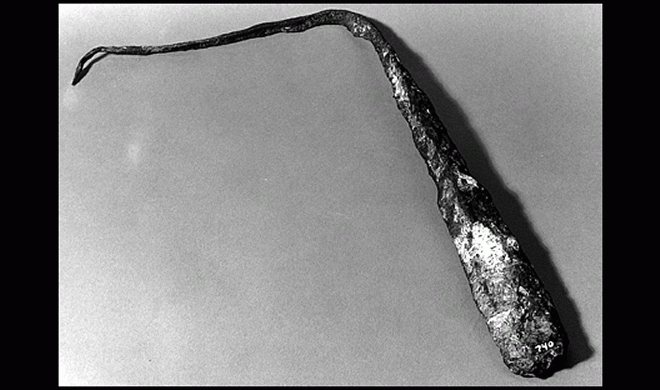
What would you think if you saw a man chasing a thunder and lightning storm on horseback? You would probably wonder what on Earth he was trying to do. Well, if you lived in the 1700s and knew Benjamin Franklin, this is just what you might see during a terrible storm. Ben was fascinated by storms; he loved to study them. If he were alive today, we could probably add "storm-chaser" to his long list of titles.
It was in Boston, Massachusetts, in 1746 that Franklin first stumbled upon other scientists' electrical experiments. He quickly turned his home into a little laboratory, using machines made out of items he found around the house. During one experiment, Ben accidentally shocked himself. In one of his letters, he described the shock as
"...a universal blow throughout my whole body from head to foot, which seemed within as well as without; after which the first thing I took notice of was a violent quick shaking of my body..." (He also had a feeling of numbness in his arms and the back of his neck that gradually wore off.)
Franklin spent the summer of 1747 conducting a series of groundbreaking experiments with electricity. He wrote down all of his results and ideas for future experiments in letters to Peter Collinson, a fellow scientist and friend in London who was interested in publishing his work. By July, Ben used the terms positive and negative (plus and minus) to describe electricity instead of the previously used words "vitreous" and "resinous." Franklin described the concept of an electrical battery in a letter to Collinson in the spring of 1749, but he wasn't sure how it could be useful. Later the same year, he explained what he believed were similarities between electricity and lightning, such as the color of the light, its crooked direction, crackling noise, and other things. There were other scientists who believed that lightning was electricity, but Franklin was determined to find a method of proving it.
By 1750, in addition to wanting to prove that lightning was electricity, Franklin began to think about protecting people, buildings, and other structures from lightning. This grew into his idea for the lightning rod. Franklin described an iron rod about 8 or 10 feet long that was sharpened to a point at the end. He wrote, "the electrical fire would, I think, be drawn out of a cloud silently before it could come near enough to strike..." Two years later, Franklin decided to try his own lightning experiment. Surprisingly, he never wrote letters about the legendary kite experiment; someone else wrote the only account 15 years after it took place.
In June of 1752, Franklin was in Philadelphia, waiting for the steeple on top of Christ Church to be completed for his experiment (the steeple would act as the "lightning rod"). He grew impatient and decided that a kite would be able to get close to the storm clouds just as well. Ben needed to figure out what he would use to attract an electrical charge; he decided on a metal key and attached it to the kite. Then, he tied the kite string to an insulating silk ribbon for the knuckles of his hand. Even though this was a very dangerous experiment, (you can see what our lightning rod at the top of the page looks like after getting struck), some people believe that Ben wasn't injured because he didn't conduct his test during the worst part of the storm. At the first sign of the key receiving an electrical charge from the air, Franklin knew that lightning was a form of electricity. His 21-year-old son William was the only witness to the event.
Two years before the kite and key experiment, Ben had observed that a sharp iron needle would conduct electricity away from a charged metal sphere. He first theorized that lightning might be preventable by using an elevated iron rod connected to the earth to empty static from a cloud. Franklin articulated these thoughts as he pondered the usefulness of a lightning rod:
"May not the knowledge of this power of points be of use to mankind, in preserving houses, churches, ships, etc., from the stroke of lightning, by directing us to fix, on the highest parts of those edifices, upright rods of iron made sharp as a needle...Would not these pointed rods probably draw the electrical fire silently out of a cloud before it came nigh enough to strike, and thereby secure us from that most sudden and terrible mischief!"
Franklin began to advocate lightning rods that had sharp points. His English colleagues favored blunt-tipped lightning rods, reasoning that sharp ones attracted lightning and increased the risk of strikes; they thought blunt rods were less likely to be struck. King George III had his palace equipped with a blunt lightning rod. The decision became a political statement when it came time to equip the colonies' buildings with lightning rods. The favored pointed lightning rod expressed support for Franklin's theories of protecting public buildings and the rejection of theories supported by the King. The English thought this was just another way for the flourishing colonies to be disobedient to them.
Franklin's lightning rods could soon be found protecting many buildings and homes. The lightning rod constructed on the dome of the State House in Maryland was the largest "Franklin" lightning rod ever attached to a public or private building in Ben's lifetime. It was built in accordance with his recommendations and has had only one recorded instance of lightning damage. The pointed lightning rod placed on the State House and other buildings became a symbol of the ingenuity and independence of a young, thriving nation, as well as the intellect and inventiveness of Benjamin Franklin.
Note: The object pictured above is part of The Franklin Institute's protected collection of objects. The image is © The Franklin Institute. All rights are reserved.

